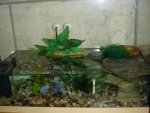There are many ways to do it. I personally add some foods to the tank, then let it decay. The decomposed matters will become ammonia which is poisonous. Then your tank will eventual develop bacteria that convert the ammonia to Nitrite. Which is still poisonous to your newt in a lesser degree. Now, wait for sometime for other bacteria to establish to convert Nitrite to Nitrate. In Nitrate form, the water is less poisonous to newt and your regular water change will keep it density in check.
What size of a tank are you keeping your eastern newt? It will take time for the water to become cycled. If you like, you may buy some chemical from aquarium store that neutralize the ammonia but slow down your cycling.
The reason your newt stay on land might because it is stressed. Had it tried to venture into water? Do you have your tank escape-proof? In situation like this, Newt will likely attempt to escape.
What I would do....
1) move your newt to a smaller container with dechlorinated water, put it at a dark, sheltered and cold place. This will help the newt to become less stressed. Also allow you to change 100% water change easily. Maybe a rock for the newt to seat on out of water as well. Keep a bucket of dechlorinated water, and let it seat at room temperature. Use this water for the 100% daily water change. You don't want to keep your newt in the tank you are trying to cycle. As the water can become harmful to the newt.
2) Fill your tank up with dechlorinated water to the desired depth, chlorinated water will kill the nitrogen cycle bacteria, which you dont want. Make sure you have some substrate so that bacteria might develop on.
3) Air pump to the water will help bacteria develop faster. A corner air pump filter will be very useful.
4) add some food to the tank and let it decay.
5) Wait for a few weeks.
6) test the water with a water test kit. it should read that Ammonia near Zero, Nitrite near Zero and Nitrate is high.
7) Change the water (conditioned water) so that Nitrate level is lowered. Maybe a 50% water change or less.
8) Reintroduce your newt to the tank.
------------
Correct me if I am wrong. Or feel free to suggest alternatives.



